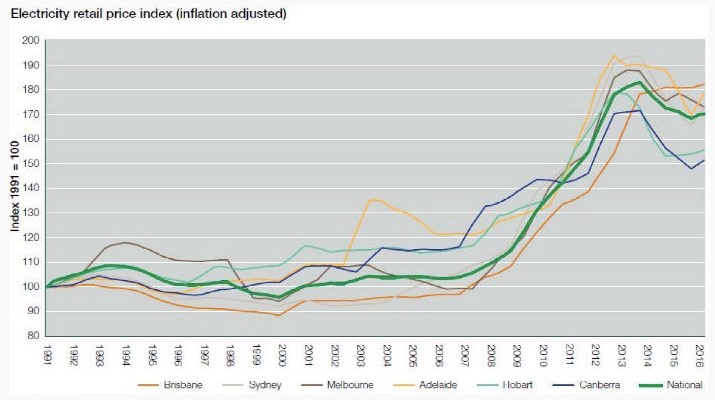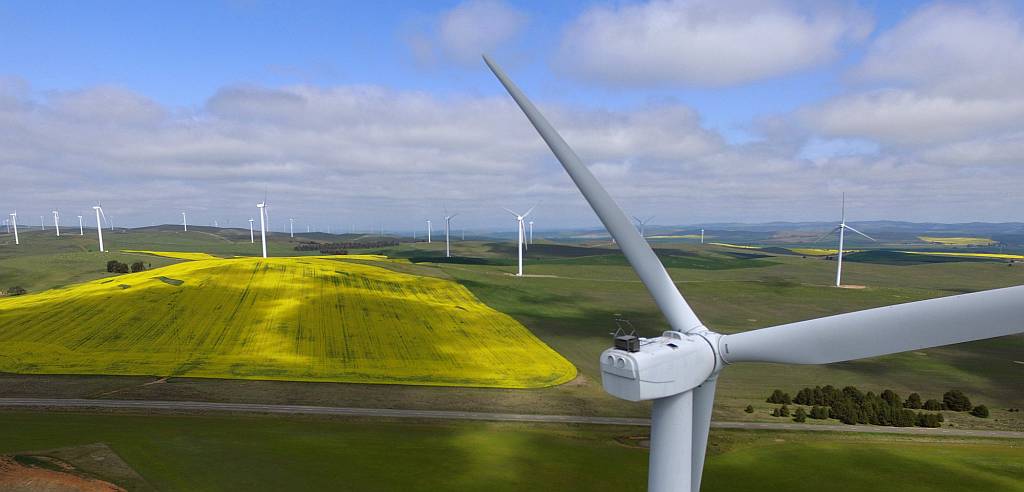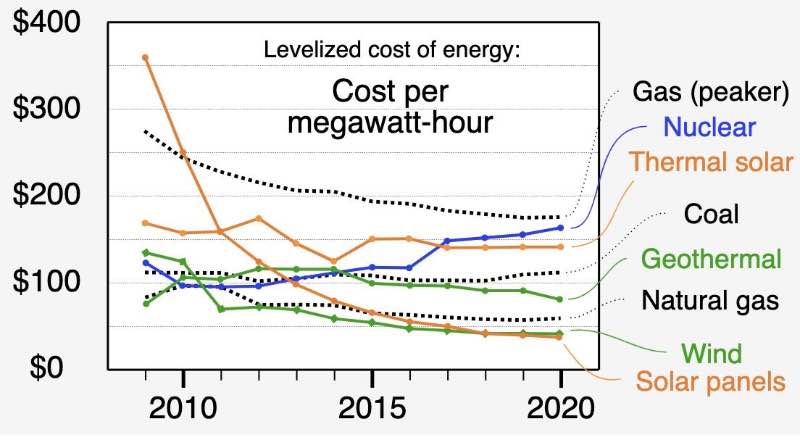| |
This section added
2021/02/13
|
|
As reported by the Institute for Energy Economics and Financial Analysis (IEEFA) in January 2021, "South Australia’s renewable-heavy grid now has the country’s lowest wholesale electricity prices".
Quoting from an article written by Giles Parkinson and published in Renew Economy on 2021/01/29:
"South Australia – maligned by conservatives over the world-leading share of wind and solar in its grid – now boasts the cheapest wholesale electricity prices in the country, even as it reaches “world first” levels of 100 per cent solar power.
The Australian Energy Market Operator, in its latest Quarterly Energy Dynamics report, confirms that South Autralia – as first reported exclusively by RenewEconomy three months ago – served all of its electricity demand for more than an hour shortly after mid-day on October 11 through rooftop and utility scale solar.
AEMO says this is a world-first in a grid of this size, and occurred in a December quarter when South Australia posted the lowest wholesale electricity prices in the country – thanks to the growing share of wind and solar and the increase in rooftop solar PV which is reducing grid demand."
|
Back in 2018 the CSIRO reported that renewables were cheaper than coal power
On 2018/12/21 Giles Parkinson wrote a piece titled
CSIRO/AEMO study says wind, solar and storage clearly cheaper than coal for RenewEconomy.
The CSIRO (Commonwealth Scientific and Industrial Research Organisation) is the preeminent Australian scientific organisation; AEMO (Australian Energy Market Operator) controls the National Electricity Market that supplies the great bulk of electricity in all but Western Australia and the Northern Territory.
Quoting the article on RenewEconomy:
"The joint study – GenCost 2018 – by the CSIRO and AEMO shows that the levellised cost of energy (LCOE) of solar and wind is well below that of any other generation source.
Even adding two and six hours of storage with batteries or pumped hydro still leaves the cost of “firm” solar and wind power cheaper than any fossil fuel alternative."
I suggest that the reader refers to the RenewEconomy link above for a summary, or to the
the original CSIRO report for a fuller account.
| |

| | Graph credit Morgan Stanley via ABC (see text)
| |
ABC business editor Ian Verrender wrote a piece on 2018/07/16 titled:
How government inaction fuelled Australia's renewable energy boom.
Quoting Ian Verrender:
"The east coast gas boom transformed Australia into one of the biggest global gas exporters but left us chronically short of gas, sending prices into orbit.
Because it plays such an important role in electricity generation – as the final player to meet peak demand – gas is the swing factor in our power bills.
These two graphs from investment bank Morgan Stanley tell the story:"
As shown on the graphs, gas prices in Australia rose particularly from 2004 to 2015, electricity prices rose steeply from about 2007 to 2014.
This has to be much more than a coincidence.
| |

| | Graph credit Morgan Stanley via ABC (see text)
| |
There are several things that should be noted on these graphs:
- Rises in national electricity prices are strongly correlated with rises in gas prices;
- The second graph shows that the electricity price rose steeply in South Australia (Adelaide) from 2002 to 2004, only the first and smallest of the state's wind farms (Starfish Hill) was built in that period;
- While far more renewable energy (particularly wind power) was built in SA in the period from 2004 onward, electricity prices rose no more in SA than elsewhere in that period;
- The rise in electricity prices in Queensland (Brisbane) in the period 2006 to 2014, during which no wind power or utility scale solar was installed in that state, was just as steep as anywhere else;
- Electricity prices fell in SA from 2012 onward, a period in which two of the state's biggest wind farms were built (Snowtown 2 and Hornsdale).
All but one of SA's wind farms were built after 2004 (see
wind farm chronology) and SA is heavily reliant on gas to generate its electricity.
Its last coal-fired power station was shut down in May 2016.
These facts suggest that blaming SA's renewable energy for its high power prices is absurd.
| |
|
This section added 2019/09/08
|
|
The detractors of South Australia's renewable energy miracle often make misleading claims about power prices.
South Australia does have high power prices, but they were high both before and after the adoption of renewable energy and they are high because SA had and has a higher percentage of expensive gas-fired generation than the other states.
According to the
Australian Energy Regulator the annual volume weighted average spot prices on the wholesale electricity market in SA have risen more in the period during which the state developed its renewable energy than in Queensland, but less than NSW and much less than Victoria.
| Average wholesale spot prices from the
Australian Energy Regulator and percentage rise in average spot prices in the period during which SA developed most of its renewable energy.
Prices in dollars per megawatt-hour.
|
|---|
| | Period | Qld | NSW | Vic | SA
|
|---|
| 5 year average before renewables | July 1998 to June 2003 | $46.6 | $34.2 | $33.4 | $51.4
|
|---|
| 5 year average following development of substantial renewables | July 2014 to June 2019 | $77.2 | $71.0 | $75.0 | $93.8
|
|---|
| Percentage rise | | 66% | 108% | 125% | 82%
|
|---|
The power price rise in SA during the period of renewable energy introduction was less than the average of that in the eastern states; 82% against 100%
It can be calculated from the table that while South Australia's power prices were 35% higher than the average for the other states before the adoption of renewables they were only 26% higher in the last five years, following the adoption of substantial renewable energy.
It is also notable that in the year to the time of writing this section (September 2019) SA has exported nearly twice as much power to Victoria than it has imported, suggesting that wholesale prices in SA have become generally lower than those in Victoria.
In addition, the ratio of exports to Victoria to imports from Victoria has been steadily increasing since late 2016.
See OpenNem.
Liz Hobday wrote for the ABC 2018/12/08 a piece titled
Renewable energy reduces power prices by more than cost of subsidies, study finds.
It discussed the findings of an independent study by the Victoria Energy Policy Centre focused on the South Australian electricity market.
Quoting from the article:
The study's lead author, Associate Professor Bruce Mountain, said the research provided verifiable evidence that renewables drive down prices.
"I think in the current climate it's critically important," he said.
"We have an evidence base that puts this issue on the table for people to engage with.
"What our study finds unequivocally is the route to lower prices lies with cleaner sources."
Wind power
| North Brown Hill Wind Farm, near Jamestown, South Australia
|
|---|

|
Photo taken with my drone, 2017/09/15
More information
|
Solar photo-voltaic
| Peterborough Solar Farm, South Australia
|
|---|

|
Photo taken with my drone, 2018/05/12
More information
|
Solar thermal
| Sundrop Farms, near Port Augusta, South Australia
|
|---|

|
Photo taken with my drone, 2016/03/14
More information
|





